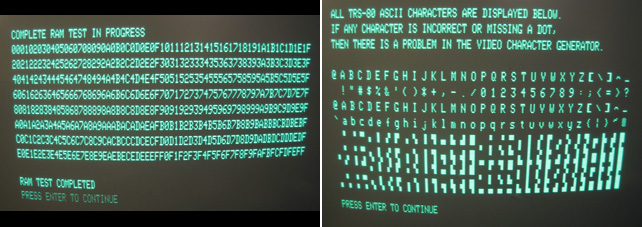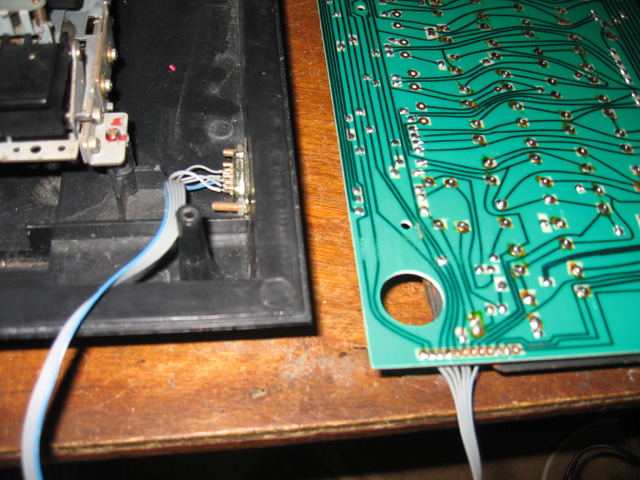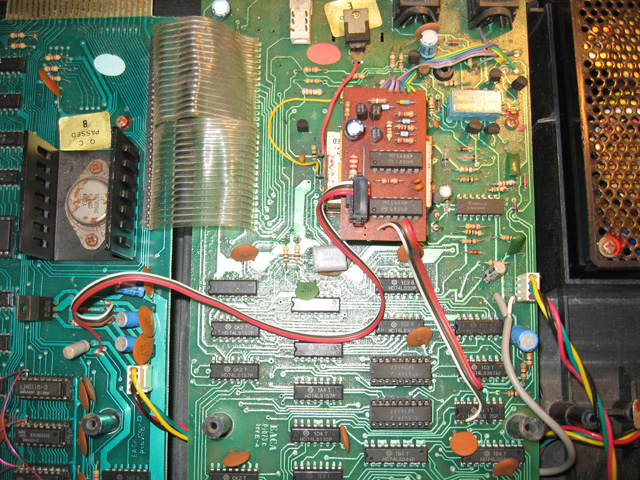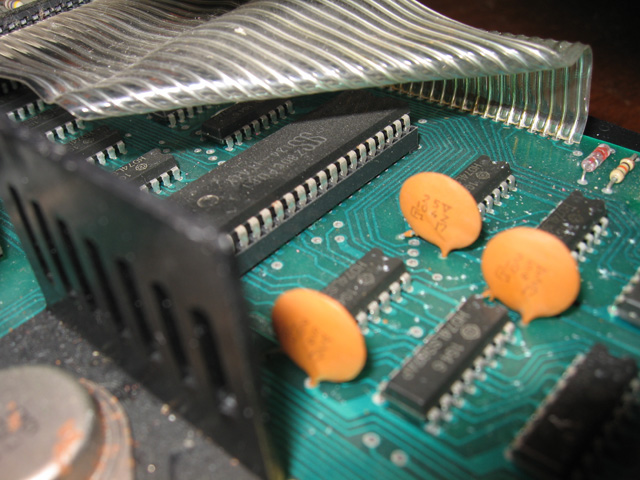Restoring a second Dick Smith System 80 Part 3: Instability and a CPU board swap
Introduction
This is part three of a restoration project to bring a junk System 80 unit back to health. So far I'd manage to re-establish some missing memory and re-cap an errant tape deck. But was this System 80 now fighting fit? Before claiming victory, I had to give it a good road test.
Testing - fine initially...
For testing I used a program called "System Diagnostic" by Howe Software. This 1982 TRS-80 Model 1 package contain diagnostic and burn-in routines for all the standard hardware. In particular, I wanted to test memory and video RAM just to make sure those essential systems were ok.
At first, things went well. A RAM check showed no problems as did a glitch and refresh test. The video test also passed with flying colours!

Figure 1. Memory and video RAM test - All fine!

Figure 2. Glitch and Refresh RAM test - Also fine!
...then odd behavior
Towards the end of the test though, some odd things started to surface. For example, suddenly the prompt was appearing in the wrong place? weird? On occasions a letter would be displayed incorrectly? Hmmm,..


Figure 3a and 3b. Input text prompt in wrong place and "continue" spelt wrong?
As characters were misspelled I wondered if the video RAM was playing up? I substituted the two ICs. Nope, the problems still persisted. In fact the longer I used the machine the worse these problems seem to get. It wasn't just with the diagnosis program. Playing games seemed to lock up or crash on occasions. Sometimes the machine wouldn't freeze but instead revert to the BASIC prompt?? Pressing RESET would give some error message like ">UL in line 2345"? On other occasions it would just go to READY? and stay there!? You could type letters in, which appeared on the same line as the sign-on word but pressing NEW LINE did nothing? Bizarre!
Keyboard modification?
Like many System 80s of the time, this one had been modified to take a joystick. I wondered if this might be causing problems as the crash/lockup symptom in games seemed to correspond with a key press? I checked the joystick adaptor connections on the keyboard and there seemed to be a short over one of the lines. Maybe this was it?

Figure 4. Joystick mod. The circuit board to the right is the underside of the keyboard
I removed the modification. However, there was no change.
Network modification?
Both machines from the System 80 haul had been modified for networking (to be covered in a separate article). Could this be the problem? The network board got its power from a lead coming off the power rails on the CPU board. Initially I unplugged this lead. No change.

Figure 5. System 80 showing the networking modification
The network sub-system was connected in a number of places from the video board though and I wondered if any of these connections fed in a secondary source of power? Unlikely, but I decided to remove the network modification anyway (after taking lots of pictures for archival purposes) thereby eliminating any possible compounding factors.
Removal though, made no difference.
A pattern emerges
I was, however, by now starting to see a pattern. When playing Defense Command for example, the system would crash JUST BEFORE the alien mothership disgorged her cargo. It would lock up for about a minute, then the BASIC prompt would appear often with other screen corruption (figure 4). That happened consistently EXCEPT when the machine had been going just a few minutes. If it was the first load of the day, it would sometimes get beyond the screen..at least for a little while.
In general, the longer the machine was on, the worse the problem got.

Figure 6. Defense command crash!
The problem seemed therefore, to be related to heat. In the first few minutes or so after switching on from cold, the System 80 would behave. It could even pass a RAM test. However, later all kinds of funny things would happen. The diagnostic program itself would crash before RAM could be tested.
So, what could this be? I figured a logic IC would crash the whole system if it failed. My gut feeling therefore was that is was faulty RAM. Not faulty enough to stop the machine working, but compromised enough when warm to shift bits around a little.
A 16k reversion?
One way to test this would be to remove the 32k RAM upgrade and revert to just 16k with known good 4116 chips. However, the upgrade not only involved stacked 4116 ICs but also some rewiring at the bottom of the board. I wasn't SURE it was RAM and if it turned out to be something else, re-installing the 32k mod would take a bit of work.
A CPU board swap
By this time I had looked more closely at the OTHER System 80 I'd received in the haul. I'd done this a few days ago with a view of it being a donor for a CPU board if I couldn't fix the missing memory issue. On an initial examination that second System 80 had shown a garbage screen when the switch was thrown. In the second examination I checked the power (it was fine), reseated all socketed ICs (that didn't work) and replaced the CPU (that DID work!).

Figure 7. Nestling under the keyboard ribbon; The venerable Zilog Z80, powerhouse of the System 80
With a replacement Z80 now powering the circuits the computer side of the machine appeared to be in full working order! Furthermore a memory check showed a full 32k of RAM.
So, this donor board described above was available in the wings. I decided to use it!
After swapping the CPU boards over I ran the diagnostic tests and games again. No problemo! I ran a four hour burn-in RAM test. Also no problems! Consequently I deemed this board A-OK and left it in this computer, relegating the faulty board to the other one. I'd see if I could fix it at another time.
I now had one healthy and fit System 80!
Reflections
I hadn't really got to the root of the instability problem as the board swap meant I didn't have to. That's the beauty of having spare parts. However, it's not a real fix. It just shifts the problem onto the donor machine. I wanted to restore that one eventually too, so repair had just been postponed. (As it was, it turned out I was right. It was RAM. That diagnosis will be the subject of another blog posting).
Even though I had a working System 80, one task still remained. Although the computer now worked to its full capacity and could load tapes, its patchy yellow keys were an ugly sight. Time for some retrobrighting, covered in the next episode.
Tez
2nd October, 2010
| Tweet |